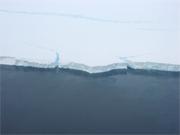 Pine Island Glacier is one of the fastest moving glaciers in Antarctica.© Eurekalert
Pine Island Glacier is one of the fastest moving glaciers in Antarctica.© EurekalertIce is sliding off the Antarctic continent much faster than it did during the 1990s, several teams of researchers have found.
On the Antarctic Peninsula that sticks out from the western side of the continent, the speeds at which several glaciers are surging into the sea have increased eight-fold between 2000 and 20031,2. And below the peninsula, in Western Antarctica, glaciers are now releasing 250 billion tonnes of ice into the Amundsen Sea each year - enough to raise global sea levels by 2 millimetres per decade3.
The results, which draw on satellite and aircraft measurements of glacier thickness and flow, highlight the disturbing potential consequences of recent climate warming in the Antarctic region.
Ice slide
The thick sheet of ice covering Western Antarctica is a focal point for fears about the effects of climate change on the frozen poles. It is particularly vulnerable because it rests on land that lies below sea level, and there is a danger that if the ice shelves surrounding it were to disintegrate, the entire ice sheet could slide into the sea.
If that happened, global sea level would rise by an awesome 5 metres: five times greater than the highest current prediction for the increase in sea level over the next century.
"The potential impacts of a major change in the West Antarctic Ice Sheet are severe," says David Vaughan of the British Antarctic Survey in Cambridge. "Sea level rise will be fantastically expensive for developed nations with coastal cities and dire for poor populations in low-lying coastal areas."
Glaciers threatened
Using data from satellites and aircraft flights, Robert Thomas of NASA's Goddard Space Flight Center in Virginia and co-workers in the United States and Chile followed the progress of several glaciers discharging into the Amundsen Sea off Western Antarctica. They found that the glaciers are getting thinner, because they are losing about 60% more ice into the ocean than is being replaced by fresh snowfall over the continent3.
The researchers think the reason so much more ice is being lost is because ice at the edges of the continent has thinned, causing it to detach from the bedrock below. No longer anchored to the rock, these marginal ice plains are less able to hold back glaciers pushing toward the coast.
For at least one of the glaciers, the Pine Island Glacier, the researchers say that if the present rate of thinning continues, "most of the ice plain should float free from its bed within the next five years". These glaciers are already the fastest moving in all of Antarctica. But if the ice floats completely free of the rock, they will speed up much more. These Amundsen Sea glaciers alone contain enough ice to raise sea level by 1.3 metres.
Breaking up
On the Antarctic Peninsula, the story is much the same1,2. A team led by Eric Rignot of the Jet Propulsion Laboratory in Pasadena, California, and a group headed by Ted Scambos at the University of Colorado in Boulder, have both found that some glaciers there are flowing several times faster than they were three or four years ago.
This region has also been a focus of concern for some time; in 2002 one of the floating ice shelves, called Larsen B, broke apart in response to the 2.5°C temperature rise the Antarctic has experienced over the past 50 years. The melting ice shelf does not in itself affect sea level, because floating ice displaces its equivalent volume of water.
But the new results reveal that the consequences of the break-up are grave. Without the restraining band of ice, the researchers found that several glaciers have surged forward at greater speed. In contrast, two glaciers where the ice shelf remains intact show virtually no speed-up.
The Larsen B ice shelf is relatively small. It's not yet clear if the changes seen for the Peninsula glaciers would necessarily scale up to the much larger ice basins that feed into the Western Antarctic ice shelves, says Julian Dowdeswell, director of the Scott Polar Research Institute in Cambridge, UK. But the fear is that if the same thing were to happen to the huge Ronne and Ross ice shelves in Western Antarctica, a catastrophic collapse could follow.
